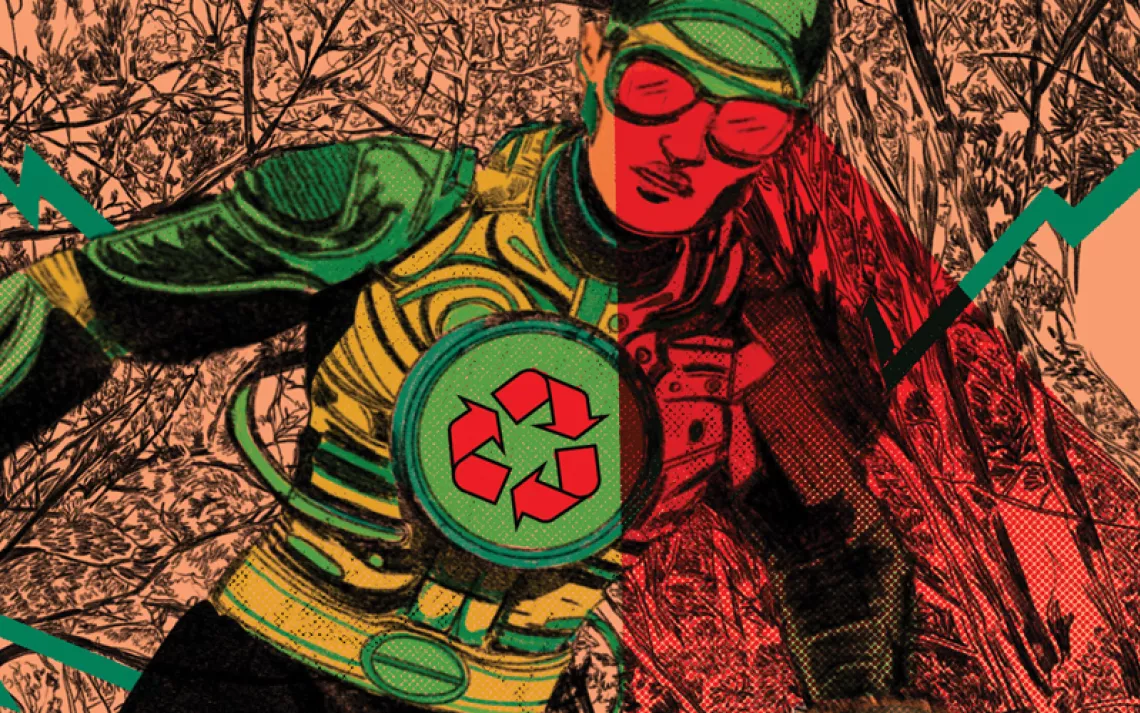What New Research and Indigenous Wisdom Teach Us About the Octopus—And Ourselves
“Secrets of the Octopus” adds to a diverse collection of cephalopod knowledge
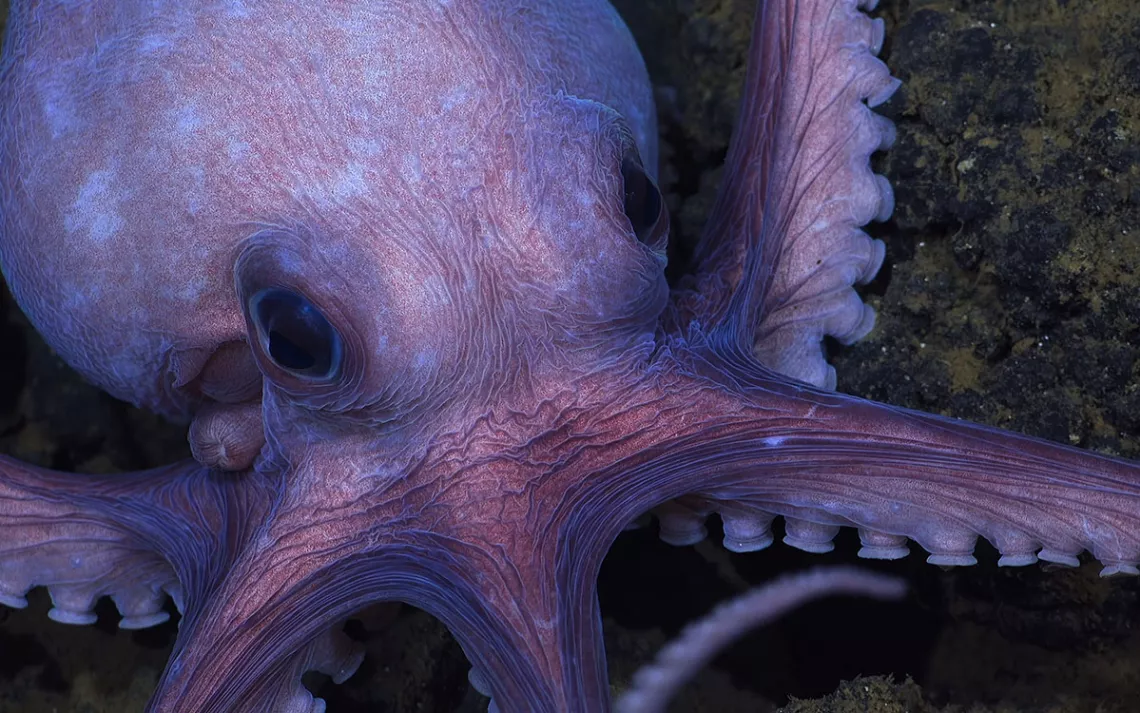
A blue-ringed octopus (Hapalochlaena maculosa) displays bright-blue rings while out of the den, a warning that her venomous bite is deadly. She navigates her world by using her front arms to taste the water for the chemical signatures of potential mates. | Photo courtesy of National Geographic
It was unlike anything anyone had ever seen: a giant octopus arm, some 20 to 30 feet long, emerging from the Prince William Sound off the coast of Hinchinbrook Island. According to Alutiiq kayakers who witnessed it back in 1900, the huge tentacle wrapped around coastal crags and stole eggs from birds’ nests before submerging again into the sea.
Today, those same waters are home to a giant rock formation just off the island’s shores, resembling an octopus’s head and arm. Called Amikuak, it means “Two Octopus” in the Aluutiq language. Its presence on the horizon reminds not only of the countless Pacific octopuses who call the sound home, but of many Alaska Native peoples’ enduring relationship with the fish.
“Including the octopus, a lot of Native cultures believe that all species, of the land and of the water, have a place in this world,” says John Johnson, the vice president of cultural resources at the Chugach Alaska Corporation. His grandmother’s uncle was one of the kayakers present for the giant octopus sighting.
Connections with octopuses throughout coastal Alaska are deeply rooted and vibrant. Subsistence fishers have depended on them for food and trade for centuries. And in what is now the state’s forested panhandle—and the historic and present homelands of the Tlingit peoples—the tribe’s Chookaneidí (octopus) Clan honors the fish on totem poles, masks, carvings, and with beadwork creations. It is a relationship they have shared since time immemorial. As is the foundation of so many Indigenous belief systems, octopuses—like all plants, animals, waters, winds, soils, and air—are respected as kin. “If our living fellows and the land itself are all of a kind, then talking to them, respecting them, and behaving responsibly are as important toward the environment as toward other humans, and always has been,” says David Scheel, a professor of marine biology at Alaska Pacific University and the author of Many Things Under a Rock: Mysteries of Octopuses.
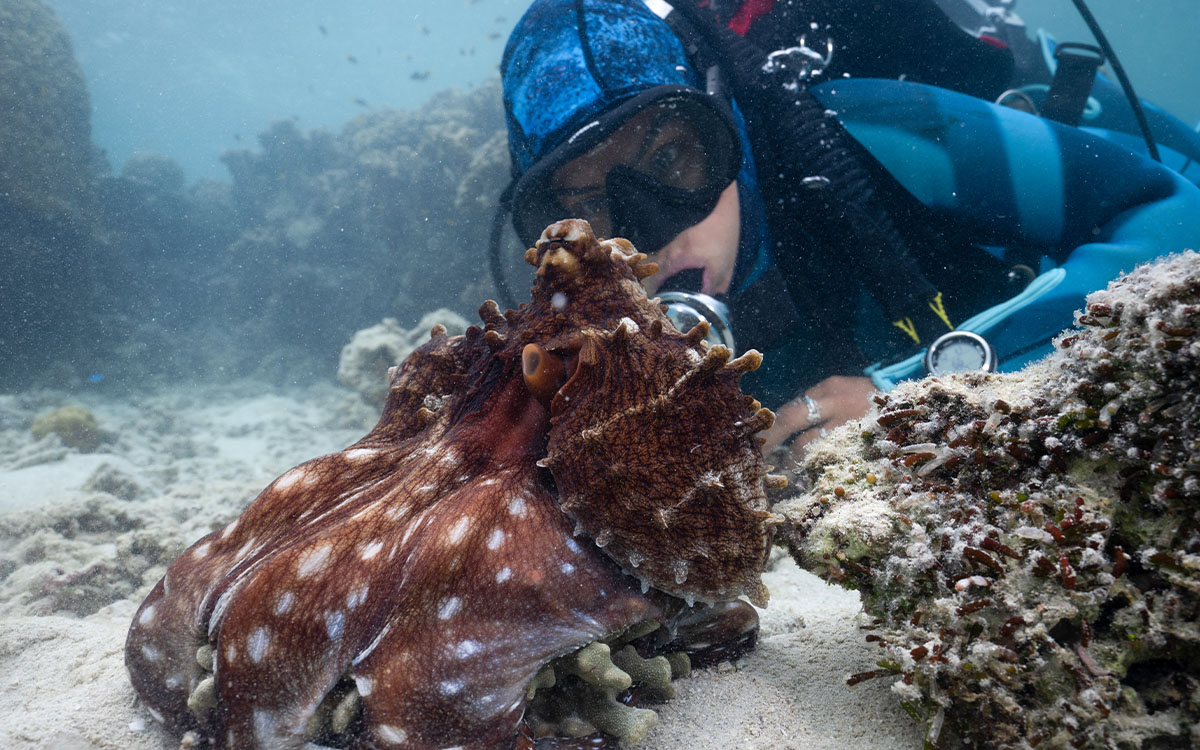
A day octopus (Octopus Cyanea) parachutes her web over a coral head, using her arms to forage in the crevices below, while Alex Schnell observes. | Photo by Craig Parry/National Geographic for Disney
That same ethos takes center stage in James Cameron’s new National Geographic docuseries, Secrets of the Octopus, which also streams on Disney+. Across the series’ three episodes—thematically titled “Shapeshifters,” “Masterminds,” and “Social Networkers”—marine biologist Alex Schnell leads viewers across the Pacific Ocean to introduce octopuses’ sprawling physical, mental, and emotional capacities. These beautiful cadences are quickly coalesced and shown by a single being: Scarlet, a day octopus named for the scar under her eye.
Scarlet became so comfortable with Schnell, on and off camera, that she came to play, clean, and then nap in the scientist’s presence. “I’m constantly fascinated by how quick they are to trust,” Schnell says. “I only spent a couple of hours with her before she reached out and decided to make contact. These interactions make time stand still.”
Schnell was also present to witness a male octopus successfully court Scarlet with a shapeshifting, color-changing slow dance. It was the first time that two octopuses mating had ever been captured on camera.
Without bones or joints, octopus arms are the most flexible limbs in the animal world. They move independently of the brain and are covered in 200 suckers. “Each is so sensitive, it’s like having a fingertip, nose, and a tongue, all in one,” Schnell says. Other stand-out moments include a blue-ring octopus filmed at nightfall, changing her skin color from cream to midnight in an instant, her signature rings popping from subdued azure to electric blue in “one of the fastest and brightest warning displays of any creature on Earth.” Later, a coconut octopus—named for the shells the species likes to gather and shelter within—uses two arms to hold a crab she just caught, and the other six to “run” across the ocean floor, an athletic maneuver called “stilt walking.”
“They can create associations, they can learn in reverse, and they have incredible spatial memory and problem solving skills,” Schnell says. “We usually think about these kinds of cognitive traits in relation to chimpanzees, gorillas, dolphins, and crows. They’re incredible learners, and that’s important to their life history.”
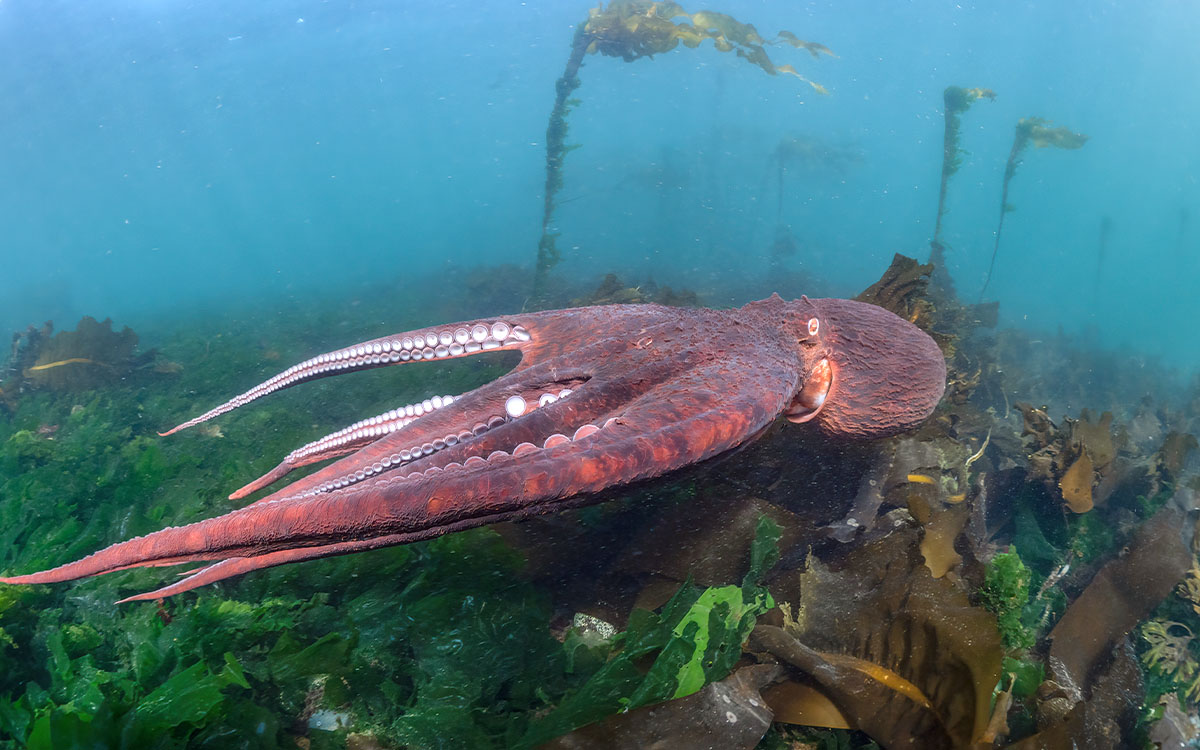
A giant Pacific octopus (Enteroctopus dofleini) jet propels over kelp in shallow waters off Vancouver Island. | Photo by Maxwel Hohn/National Geographic for Disney
Eduardo Sampaio, a postdoctoral cephalopod researcher at the Max Planck Institute of Animal Behavior, has focused much of his research on these very interactions. The social lives of octopuses in Egyptian, Israeli, Australian, and Japanese waters, he says, can be surprisingly punchy. While hunting, day octopuses form allegiances with different fish species, such as coral groupers and goat fish, he says. The partners identify and signal where prey is hiding, and octopuses swoop in, scattering food for all. Usually, everyone plays nice—but he’s also witnessed partnerships go awry and octopuses take matters into their own arms. When prey is present, they’ll sometimes punch other fish to indicate that they want their share; when prey is absent, they hit the other fish for being too greedy, or failing to hold up their end of the hunt.
Because octopuses are so good at understanding and manipulating the behavior of other fish, Sampaio says, scientists have actually come to understand other species through them. “This has opened people's minds to what sociality even is,” he says.
While in Japan, Sampaio spent two months in Sam Reiter’s lab, where the talk of the world’s cephalopod circles in the past year originated: the discovery that octopuses engage in two-stage sleep, which means they fall into REM cycles and likely can dream. “[Two-stage sleep] has been linked to memory consolidation and clearing metabolic waste from the brain,” says Reiter, a computational neuroethologist at the Okinawa Institute of Science and Technology. “Predominantly, it’s been linked to creativity.”
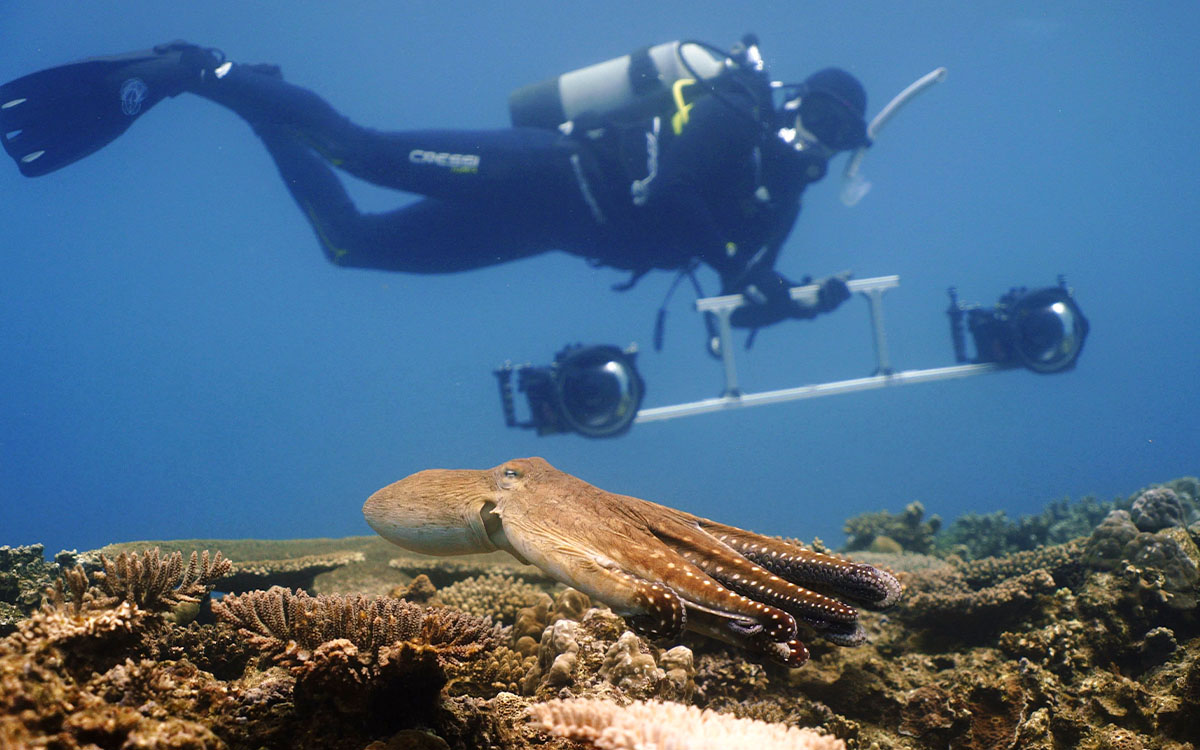
Eduardo Sampaio films a day octopus in Australian waters. | Photo courtesy of Eduardo Sampaio
The discovery, discussed in the docuseries, has sparked comparisons between how invertebrate octopuses and vertebrate humans evolved—independently, yet on similar paths—in their respective domains of sea and land. Despite our common ancestor being approximately 600 million years old, humans’ and octopuses’ similar sleep rhythms demonstrate that “evolution has hit upon the same solution twice,” Reiter says. Called convergent evolution, this process also gave both humans and octopuses the same eyeball structure, with a lens and a retina. But this didn’t carry through to the octopus’s brain, which has a structure so fundamentally dissimilar from those of vertebrates, with virtually no analogous regions, that the field of cephalopod neuroscience is only just beginning to be explored.
Octopuses have been known to attempt escapes from their tanks and cheekily squirt water on their least favorite caretakers. Stories like these offer anecdotal bases on which further experiments about cephalopod emotions, relationships, and cognition can be conducted, Reiter says.
Indigenous stories, meanwhile, capture the heritage of the relationship between our species and theirs, spanning generations.
“Native people believe there’s a spiritual world in the water and above ground, and all species fit in,” Johnson says. “None is smarter or dumber or better than the next. We all coexist together.”
 The Magazine of The Sierra Club
The Magazine of The Sierra Club



